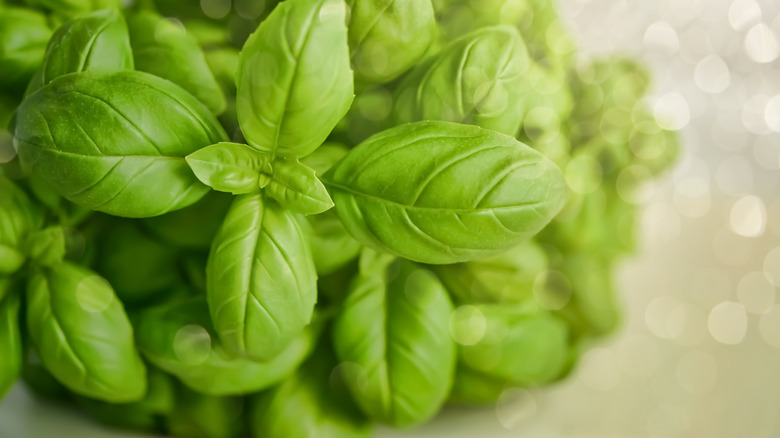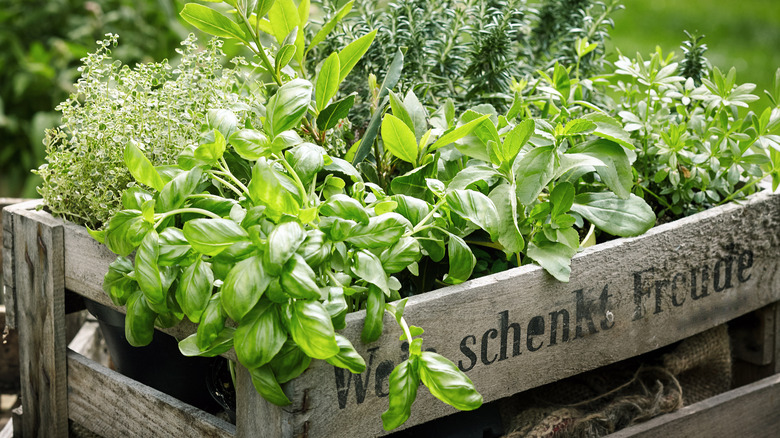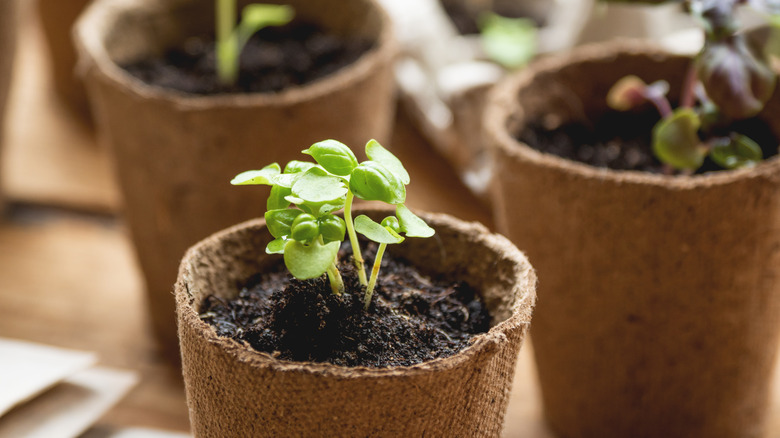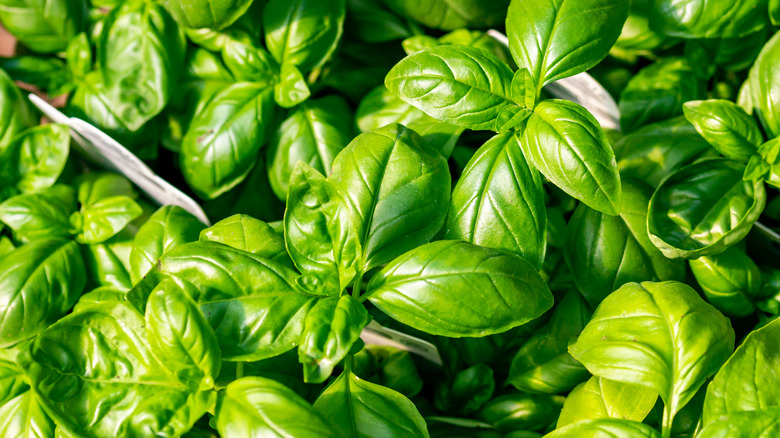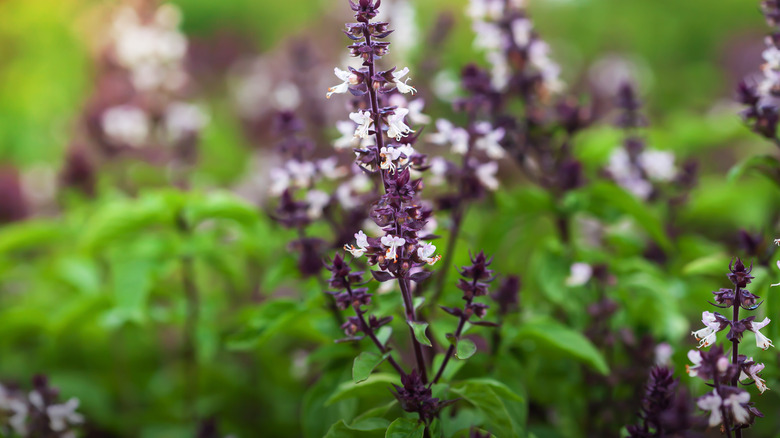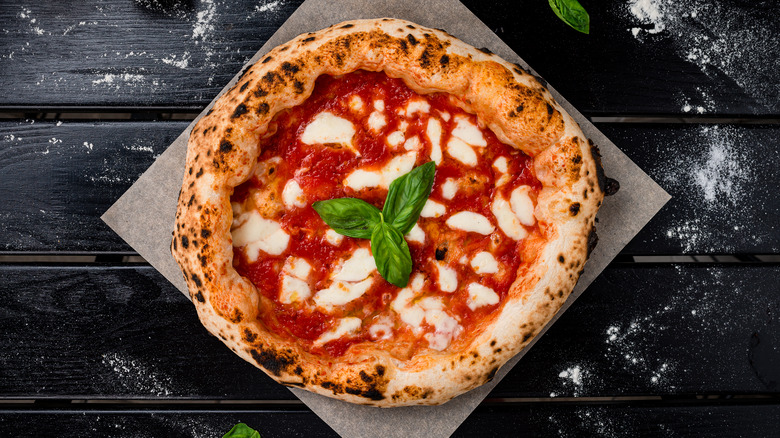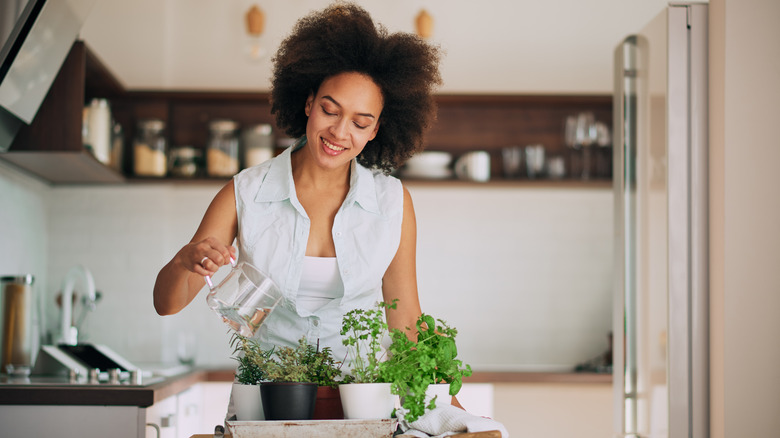How To Grow And Take Care Of Basil Plants
Basil, also known by its scientific name Ocimum basilicum, is one of the most instantly recognizable culinary herbs. A member of the mint family, basil is known for its bright green, aromatic leaves and multitude of uses in the kitchen. The leaves of the plant are oval-shaped and grooved with a slightly tapered tip. Each glossy leaf sits opposite from another on the stem. Once a basil plant reaches maturity, it will sprout small white or purple flowers from the stem. According to Almanac, basil plants can grow up to 2 feet tall.
Though no one is quite sure where basil originates from, according to The Spruce Eats, it likely was first cultivated in India. Some records suggest that humans have been enjoying this fragrant herb as early as 807 A.D. Though basil's origins can't be pinned down exactly, the easy-to-care-for nature of the plant led it to quickly become a worldwide cooking staple.
How to use basil plants in garden
If you're looking to grow your own herb garden, basil is a must-have addition. Though once established it's an easy plant to care for, according to Almanac, it's important to keep in mind that this herb can only be grown outdoors in many climates in the U.S. during extremely warm temperatures. Almanac also recommends growing tomato plants next to your basil -– they pair well together both in the garden and in the kitchen.
One way to have fresh basil year-round is to simply plant it in a pot. That way, your basil plant can soak up the warmth and sun of the outdoors, and when temperatures start to cool down, it can continue growing simply by bringing the pot inside. Finally, it's important to note that if you intend to eat the plant, do not use insecticides or other chemicals in the soil as the plant will absorb them -– and no one wants to eat insecticides.
How to grow basil plants
Luckily for fans of homemade pesto, basil is relatively easy to grow both indoors and out. Since it's an annual plant, it grows very quickly; about a month after planting your basil seeds, you'll be able to have your first harvest.
When growing basil indoors, it's important to have the proper tools. According to The Spruce, basil enjoys moist, well-draining soil mixed with organic compost, like nutrient-rich egg shells. When selecting your starter pots, be sure to get ones with ample drainage holes. If you're growing your basil from seed, you'll need a seed starting tray and a 4-inch container for when the plant has grown. When growing basil outdoors, Miracle Gro recommends planting the seedlings about 1/2 inch deep and about 12 to 18 inches apart.
If you can't get enough basil, you're in luck: Propagating the herb is pretty easy. According to Gardening Know How, you simply have to slice off a 4-inch section of the herb from under a leaf node and put the plant into a cup of water. It's best to put the cutting on a windowsill or other area that receives ample sunlight. Swap out fresh water every couple of days, and once about 2 inches of root have grown, you can plant your new basil.
How to care for basil plants
Basil is a very hardy plant and easy for even beginners to grow. According to Almanac, basil plants should ideally get six to eight hours of full sun, but partial sun will do. Additionally, the soil temperature should never drop below 50 degrees Fahrenheit.
If your indoor basil plant is struggling to get enough sunlight, consider using a grow light. According to The Spruce, basil plants should be kept under grow lights for 12 hours a day. Make sure the light bulbs are at least a few inches away from the plant so it doesn't get burned.
Whether you're growing your basil indoors or out, keeping the soil damp is crucial. If the first inch of soil is dry, it's time to water it, usually once or twice a week. Additionally, basil enjoys a bit of humidity so be sure to mist your indoor basil plant a couple of times a week.
Basil plant varieties
With over 30 known varieties of basil out there, your favorite basil-based recipes have an endless amount of iterations. Basil's longstanding history as a go-to culinary herb means that variations of the plant have been engineered in many different parts of the world, per Gardening Know How. The most common type of basil is known as sweet basil (via Taste of Home). Other types of basil include:
-
Thai basil: This is a bold and spicy herb that goes great in many Asian-inspired dishes.
-
Lemon basil: This herb is citrusy and bright; it goes great in salads or with fish.
-
Holy basil, also known as tulsi: This is a sacred herb in Hinduism and is found in many Thai dishes.
-
Mammoth basil: As the name suggests, it is huge. Its leaves can grow up to 16 inches in length.
-
Greek basil: This mild variety of basil is often found in meat dishes, soup, and applied as a garnish.
Are basil plants toxic?
As most people know, basil isn't toxic to humans or animals, per the ASPCA. When it comes to incorporating herbs into recipes, basil is a go-to for chefs and everyday cooks alike. According to Dellalo, the inclusion of basil is most prolific in Italian recipes. For example, as noted by Eat and Walk Italy, pesto, that delicious sauce comprised of pine nuts, salt, basil (of course), parmesan cheese, and olive oil originates from the Liguria region of Italy. Basil is also often found in dishes like Margherita pizza, which according to HuffPost, earned its name from Margherita of Savoy, the queen consort of Italy, because she had such an affinity for the flavors of mozzarella, basil, and tomato -– colors that happen to mimic the Italian flag.
Beyond its traditional Italian roots, basil makes a great addition to recipes you're probably already utilizing, such as salads, omelets, or even cocktails. When cooking with basil, it's important to tear the leaves as that, according to SPICEography, allows the flavor to permeate a dish most easily.
How to repot basil plants
Oftentimes, basil plants from places like the grocery store come in plastic containers unsuitable for proper growth and should be immediately repotted. Or, perhaps your basil plant has simply grown too big for its current container.
According to Ready to DIY, to repot your basil, start by adding a layer of potting soil, a few centimeters, to the bottom of your new container. Next, pick up the container with the plant and, if applicable, squeeze the sides, loosening the soil. If your container can't be squeezed, gently prod the soil with your fingers or a trough to loosen it. Once the soil isn't as tightly packed, slide your fingers to the bottom of the pot, feeling for the end of the plant's roots. Remove the plant and deposit it in its new container. Its soil should reach nearly to the top of the container with just a couple of centimeters of free space above it. Then, water your basil until water comes out of the drainage holes in the new container.
